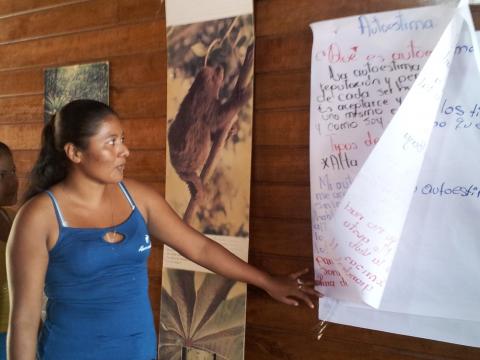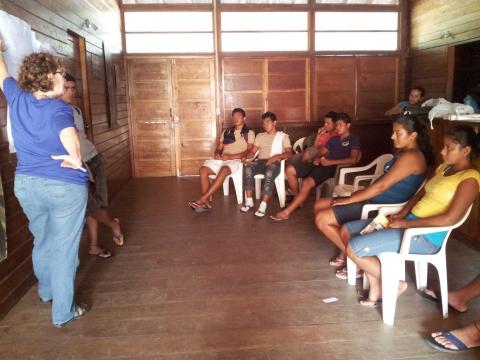Not In Our School (NIOS) is excited to publish this three-part series of three blogs about bullying in English and Spanish. In this first blog, we give an overview of bullying and share new NIOS Spanish materials. In the second blog, we share important information and useful resources on bullying from Spanish speaking countries. Finally, in our third series, we share the work of a Mexican anti-bullying activist.
Este blog también está disponible en español.

According to the 2012 American Community Survey conducted by the U.S. Census Bureau, Spanish is the most widely understood language in the Western Hemisphere, with significant populations of native Spanish speakers ranging from the southern tip of Patagonia to as far north as Canada. And in the United States, Spanish is the primary language spoken at home by 38.3 million people aged five or older, a figure more than double that of 1990. So, it is important to share NIOS films and lesson guides with the Spanish speaking world.
At a recent workshop, a principal shared a horrific story of a little 8-year-old girl who was bullied for being different. In this case, she was different because her family was not poor like the families of her classmates. So, they teased her every day. They threw things at her and pushed her. Although she did not tell anyone about what was happening to her, one day she took her parents’ gun out. Her plan was to take it to school and shoot the classmates who were tormenting her. Her parents discovered it and took the gun away, but her peers found out. That day they pelted her with stones and rocks until she had to be taken to the hospital, beaten and bloody.
This took place in a small rainforest village in the region around Rio San Juan, in Nicaragua. Recently, I had the privilege of giving two NIOS bullying prevention presentations there, one to students and another to educators. Although some of the participating schools were one-room schoolhouses, miles from the next town, both the youth and educators who attended were very familiar with bullying behaviors and were seeking solutions.
The kind of bullying that happened to this 8-year-old girl is not unlike some of the torments that happen to children everywhere. The girl’s peers claimed the reason they did it was that she was “stuck up.” Every day, children explain their cruel behavior with similar comments, like actor Christian Bale, bullied in England as a child because he was an actor; Rihanna from Barbados, bullied for her skin color and breasts; or a fifth grader in a California school where I worked as a principal, who nonchalantly told me he bullied a younger child simply because he had been bullied.
In Russia, like Nicaragua, the English word “bullying” is now being used because there is no fully comparable term. I wondered about other languages. After searching, I found a forum discussion about the word for “bully” in other languages. Different forum contributors indicated that Arabic, German, Hebrew, and French do not have exact translations for a specific word that means bullying. That caused the forum conversation participants to ponder if bullying was an American phenomenon and whether the US is making a word become a reality. The story of the Nicaraguan 8-year-old should put that theory to rest.

I believe that forms of bullying and intolerance have been around since the beginning of time. The difference now is that people across the world are recognizing it and doing something about it. With the little Nicaraguan girl, the school has gotten involved to not only help the girl and her family (who did end up changing schools), but also to work with her elementary peers.
Not In Our School is reaching out across the globe to share stories and materials in places like Hungary, Australia, Slovakia, and most recently in South Africa. We believe that this effort brings us together to make a difference and strengthens the work we are all doing. Do you have an international story? Please share it. It brings out the humanity in all of us.
As a way to share our materials with Spanish speaking countries and hispanic populations within the US, Not In Our School is now pleased to be translating our most popular films and lesson plans into Spanish. You can find our growing list of Spanish resources by clicking here.
NIOS thanks Vivianne Hiriart for her generous help doing these excellent translations pro bono.
NIOS Presenta Sus Nuevos Materiales en Español
No en Nuestra Escuela (NIOS) se complace en publicar esta serie de tres partes conformada por tres blogs sobre bullying en inglés y en español. En el primer blog damos una visión general sobre el bullying y compartimos nuevos materiales de NIOS en español. En el segundo blog, compartimos información importante y recursos útiles sobre bullying de países de habla hispana. Finalmente, en nuestra tercera serie, compartimos el trabajo contra el bullying de una activista mexicana.
De acuerdo con la Encuesta de la Comunidad Americana de 2012, llevada a cabo por el departamento de Censos de Estados Unidos, el español es la lengua más ampliamente entendida en el hemisferio occidental. Las comunidades de hispanoparlantes se extienden desde la punta más austral en la Patagonia hasta el extremo norte en Canadá. En los Estados Unidos 38.3 millones de personas mayores de 5 años hablan español como lengua principal en sus hogares; más del doble de las que había en 1990. Por eso es importante compartir los videos y actividades de NIOS con el mundo hispanohablante.
En un taller reciente, la directora de una escuela compartió la historia espeluznante de una niña de 8 años que fue víctima de bullying por ser diferente. En este caso, ella era diferente porque su familia no era pobre como lo eran las del resto de sus compañeros. Así que la molestaban todos los días. Le arrojaban cosas y la empujaban. Aunque no le dijo a nadie lo que le estaba pasando, un día tomó la pistola de sus padres. Su plan era llevarla a la escuela y dispararle a los compañeros que la atormentaban. Sus papás la descubrieron y le quitaron la pistola, pero sus compañeros se enteraron. Ese día la bombardearon con piedras y rocas hasta que tuvieron que llevarla al hospital, golpeada y ensangrentada.
Esto sucedió en un pequeño pueblo en la selva en una región cercana a Río San Juan, en Nicaragua. Recientemente tuve el privilegio de dar dos presentaciones sobre prevención de bullying en ese pueblo, una con estudiantes y la otra con docentes. Aunque algunas de las escuelas participantes se encontraban a millas de distancia del siguiente pueblo y contaban sólo con un salón de clases, tanto los jóvenes como los docentes conocían bien el bullying y estaban buscando soluciones.
El tipo de bullying que vivió esta niña de 8 años no es diferente a algunos tormentos que viven otros niños en muchas partes. Los compañeros de esta niña de 8 años afirmaban que habían actuado así porque ella era “estirada”. Todos los días los niños explican sus comportamientos crueles con afirmaciones similares, como el actor Christian Bale, quien fue víctima de bullying durante su niñez en Inglaterra por ser actor; Rhiannon, de Barbados, a quien molestaban por su color de piel y sus pechos o como un alumno de 5º grado en una escuela en California donde trabajé como directora, quien con total indiferencia me dijo que molestaba a un niño menor simplemente porque él había sido víctima de bullying.
En Rusia como en Nicaragua se utiliza la palabra inglesa “bullying” porque no existe un término que describa su significado de la misma manera. Me pregunté qué sucedía con otros idiomas. Tras buscar, encontré un foro de discusión sobre el equivalente de la palabra “bully[VH1] ” en otros idiomas. Diferentes participantes del foro indicaron que en árabe, alemán, hebreo y francés no existe un término que describa de manera exacta lo que significa bullying. Esto llevó a los participantes a plantearse si el bullying era un fenómeno estadunidense y si acaso Estados Unidos está haciendo que la palabra se transforme en una realidad. La historia de la niña nicaragüense de 8 años rebate esa teoría.
Creo que desde el inicio de los tiempos han existido formas de bullying e intolerancia. La diferencia es que ahora alrededor del mundo hay gente que lo está reconociendo y haciendo algo al respecto. Con la pequeña nicaragüense de 8 años, la escuela se involucró no sólo ayudando a la niña y su familia (quien finalmente se cambió de escuela), si no también trabajando con sus compañeros de la misma edad.
No en Nuestra Escuela (NIOS) está extendiendo sus contactos alrededor del mundo para compartir historias y materiales en lugares como Hungría, Australia, Eslovaquia, y más recientemente en Sudáfrica. Creemos que este esfuerzo nos une para hacer la diferencia y fortalece el trabajo que todos estamos haciendo. ¿Tienes alguna historia internacional? Por favor compártela. Sacan el lado humano en cada uno de nosotros.
Add new comment